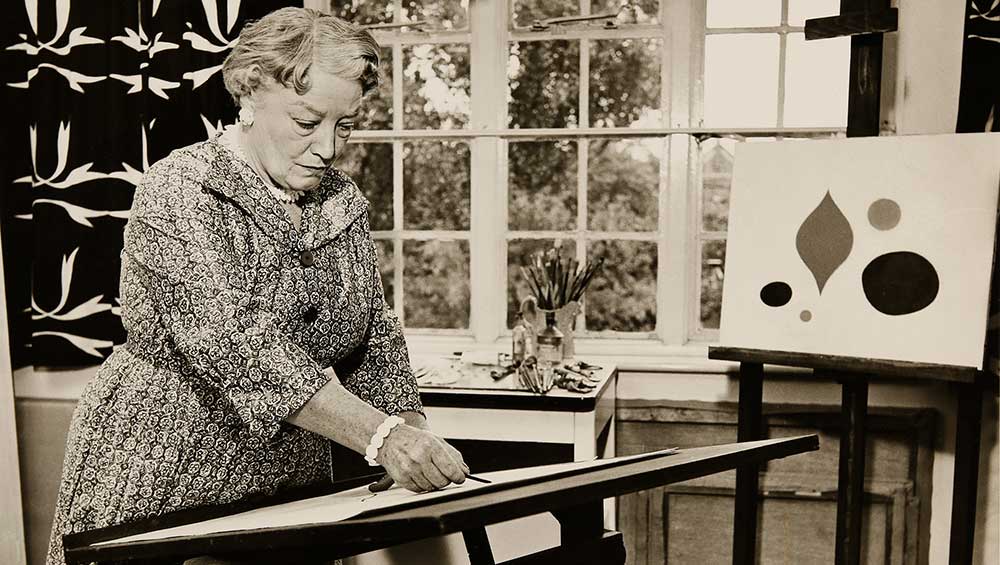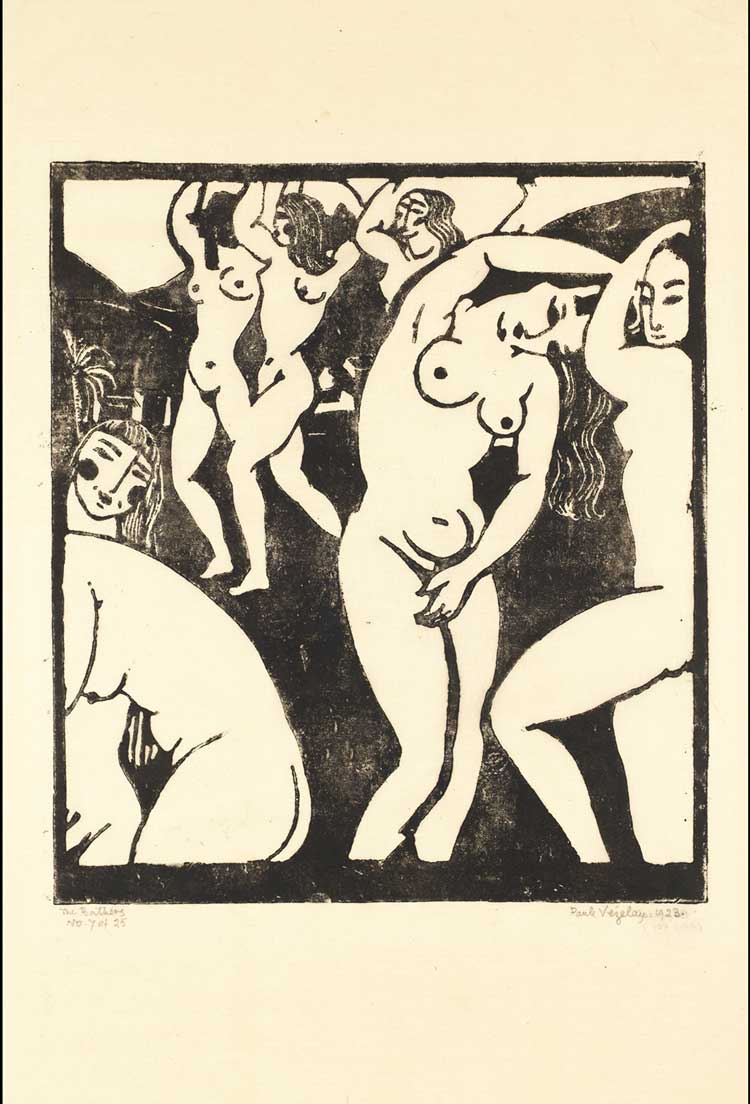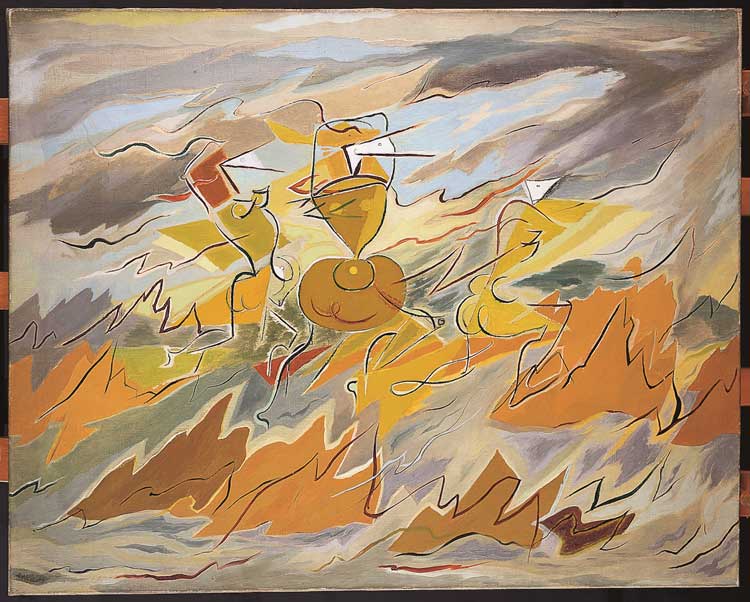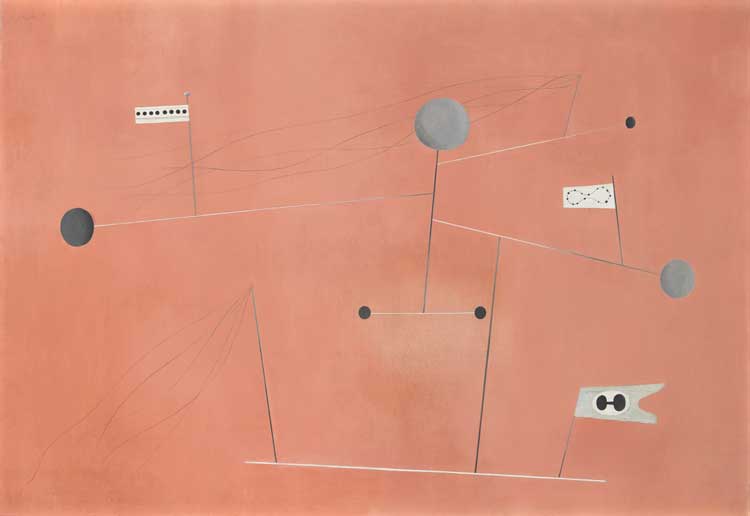
Paule Vézelay in her London studio with her 1955 textile Harmony (left) and her 1956 painting The Yellow Circle (right). Photograph, Estate of Paule Vézelay.
Royal West of England Academy, Bristol
25 January – 27 April 2025
by DAVID TRIGG
As one of the first British artists to fully embrace abstraction, Paule Vézelay (1892-1984) was a formidable presence in the European avant garde of the 1930s. Working from her Paris studio, she positioned herself at the intersection of surrealism and abstraction, producing distinctive paintings and constructions characterised by rhythmical curvilinear shapes and biomorphic forms. In France, she mixed with artists such as Sophie Taeuber-Arp, Wassily Kandinsky and Alexander Calder while exhibiting widely at commercial galleries and with progressive artist-led groups such as Abstraction-Création. This was all a far cry from her upbringing in Bristol, where she was born Marjorie Watson-Williams and studied at the conservative Bristol School of Art in the same building that is aptly hosting this jewel-like exhibition of her work, the most significant since her retrospective at the Tate Gallery in 1983.
With the support of her father, Vézelay was able to pursue her dream of becoming an artist by enrolling at the Slade School of Fine Art and the London School of Art. At this time, the young artist (working as Watson-Williams) was enamoured with the energy of theatre, circus and dance. Two figurative pictures from 1918 give us a sense of her early, impressionistic aesthetic, including a watercolour capturing the audience in a packed Bristol Hippodrome. Although she was finding some success, the parochial English art scene was stifling her ambitions and she set her sights on Paris, the vibrant epicentre of modernism.

Paule Vézelay. Bathers, 1923. Tate, presented by the artist 1973. © the Estate of Paule Vézelay. Photo: Tate.
Vézelay first visited the French capital in 1920 and, within a few months, began exhibiting at the Galerie des Feuillets d’Art. Her time in the city prompted numerous linocuts and woodcuts, including several scenes of the Cirque Medrano, a venue that inspired Picasso, Modigliani and Miró among others. Its key attraction was the flamboyant antics of the Fratellini clowns. Recently rediscovered in the Royal West of England Academy (RWA) collection, the black-and-white linocut Mr Fratellini in his Dressing Room (1923) depicts Paul Fratellini in full costume. The intimate print suggests that Vézelay was not satisfied with merely being a spectator but, typifying her independent spirit, had made her way backstage to become acquainted with her subject.
In 1926, she relocated permanently to Paris, taking a well-lit studio in Montparnasse. As the art historian Sarah Wilson writes in the catalogue, Paris offered her an opportunity for “self-fashioning, self-reinvention, linked with place, time and remarkable encounters”. It was here that she changed her name to Paule Vézeley, taking her new surname from the historic French hilltop town in Burgundy known for its great Benedictine abbey. The ambiguous name Paule was chosen, she said, to avoid “this question of sex [being] dragged into discussions about my work”. Yet despite this act of aligning herself with the School of Paris, she continued to regard herself as an English artist.

Paule Vézelay. Walking in the wind, 1930. Oil on canvas. Private Collection, courtesy England & Co., London.
In the late 20s, Vézelay’s work became increasingly abstract, with paintings such as The Sunbathers (1929) and Nudes (1930) deconstructing the human form into organic shapes and flowing, sinuous lines. Although she abandoned circus and theatre motifs, the energy of performance continued to permeate her works. Her stylistic shift coincided with her intense and turbulent relationship with the surrealist artist André Masson, whose horrific experiences in the first world war had led to violent mood swings and physically abusive behaviour. The couple’s tumultuous affair is reflected in agitated works such as Walking in the Wind (1930), the jagged, fragmented lines of which evoke a tempestuous clash of emotions. After they broke up in 1932, Vézelay’s style loosened considerably. As the show’s curator, Simon Grant, notes: “It was as if her line, previously bound and tethered, had become unleashed.”

Paule Vézelay. Construction Grey Lines on Pink Ground, 1938. Tate, purchased 1973. © the Estate of Paule Vézelay. Photo: Tate.
Vézelay was now embracing biomorphism, which reflected her love of the natural world. This period produced some of her most celebrated works, such as Strange Landscape (1933), a vibrant composition of abstracted shapes and conical forms. There are clear visual similarities between Vézelay’s works and those of Taeuber-Arp and her husband, Jean Arp, with whom she was great friends. Arp’s Concretion sculptures inspired her to experiment with three dimensions, prompting white plaster sculptures with rearrangeable elements such as Garden (1925), a table-top-sized biomorphic form filled with sand and objects collected from French beaches. Nearby hangs a Calder mobile, the poised lines of which are echoed in Vézelay’s painting Construction. Grey Lines on Pink Ground (1938), in which slender shapes resembling modernist weather vanes hover against a stark, monochrome ground. It would be wrong, however, to label Vézelay’s works as derivative. Certainly, she took inspiration from the work of others, but she always made it her own, continually pushing and experimenting.
The simple arrangements of biomorphic forms in her earlier works laid the groundwork for more complex pictures such as Youth Leaving Old Age (1934), a dynamic composition full of energy and movement in which flowing organic shapes and lines dance across an indeterminate space. Her lines leave the canvas altogether in Lines in Space No 3 (1936), a spare and delicate geometric construction with cotton threads strung across a box frame. She regarded such works among her most advanced creations, describing them as “living lines”. She would continue to develop the series well into the 1960s; an example from 1965 sees her manipulating a length of metal wire into a twisted sculptural form that casts spaghetti-like shadows on its plinth.
![Paule Vézelay, Paysage [Landscape], 1946. Oil on canvas. Private Collection, courtesy England & Co., London.](/images/articles/v/065-vezelay-paule-2025/14-Paysage_1946.jpg)
Paule Vézelay, Paysage [Landscape], 1946. Oil on canvas. Private Collection, courtesy England & Co., London.
The advent of the second world war forced Vézelay to return to Bristol, where she found work as an unofficial war artist, recording bomb damage and a barrage balloon centre. Although they seem a world away from her Parisian works, these accomplished figurative drawings are evidently studies in form – a continuation of her explorations of line and shape. After the war, she settled permanently in England though she continued exhibiting in France. The natural world remained a constant inspiration, sometimes more obviously in paintings such as Paysage (1946) with its simplified leaf forms, and sometimes more obliquely, as in the dynamic Eight Curved Forms and Two Circles (1946), a colourful work resembling microscopic organisms, which is being shown here for the first time.

Paule Vézelay. Eight Curved Forms and Two Circles, 1947. Collection of James Trotman; courtesy James Trotman © the Estate of Paule Vézelay.
Whereas some of Vézelay’s later works see her retreading ideas from the 30s, others show her venturing into new territory, especially in the 70s when she experimented with “pure colour compositions” – delicate, luminous pastel abstractions inspired in part by her interest in the work of JMW Turner. The real revelation here though are the little known textile designs she produced in London from the late 1940s in order to supplement her modest income. Initially, she sold six designs to Jean Bauret, whose firm La Société Industrielle de la Lys had previously commissioned Kandinsky. Commissions from other firms followed, but it was with Heal’s that she had her greatest success. Of the 27 designs she sold to the British homeware firm between 1954 and 1967, 15 were put into production.
One of these, Perception (1961), features columns of larger and smaller arrow-like motifs arranged at right angles to each other on a solid yellow background. Another, titled Modulation (1963), comprises organic, vine-like columns that recall her nature-inspired works of earlier years. Vézelay often worked out her designs using paper or balsa wood cutouts, a selection of which are displayed in a vitrine, echoing the forms seen in many of her postwar paintings.
Although the exhibition fills only two rooms at the RWA, it covers an enormous amount of ground, giving a sense of Vézelay’s determination and resilience in the face of repeated setbacks and misogyny. Alongside the many works on display are letters, photographs and ephemera that round out the show, offering further insight into her remarkable career and complex personality. Yet despite exhibiting regularly from the 1920s until her death, she remains an obscure figure. In seeking to redress her neglect, Grant reveals a pioneering artist who, alongside better-known names such as Barbara Hepworth, Ben Nicholson and Henry Moore, deserves to be regarded as a major figure in 20th-century British art.